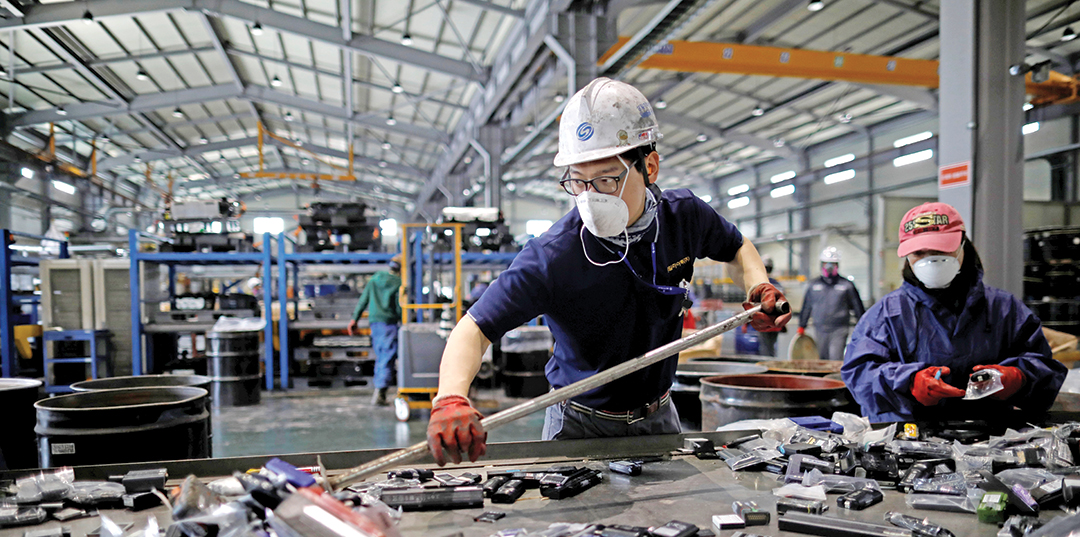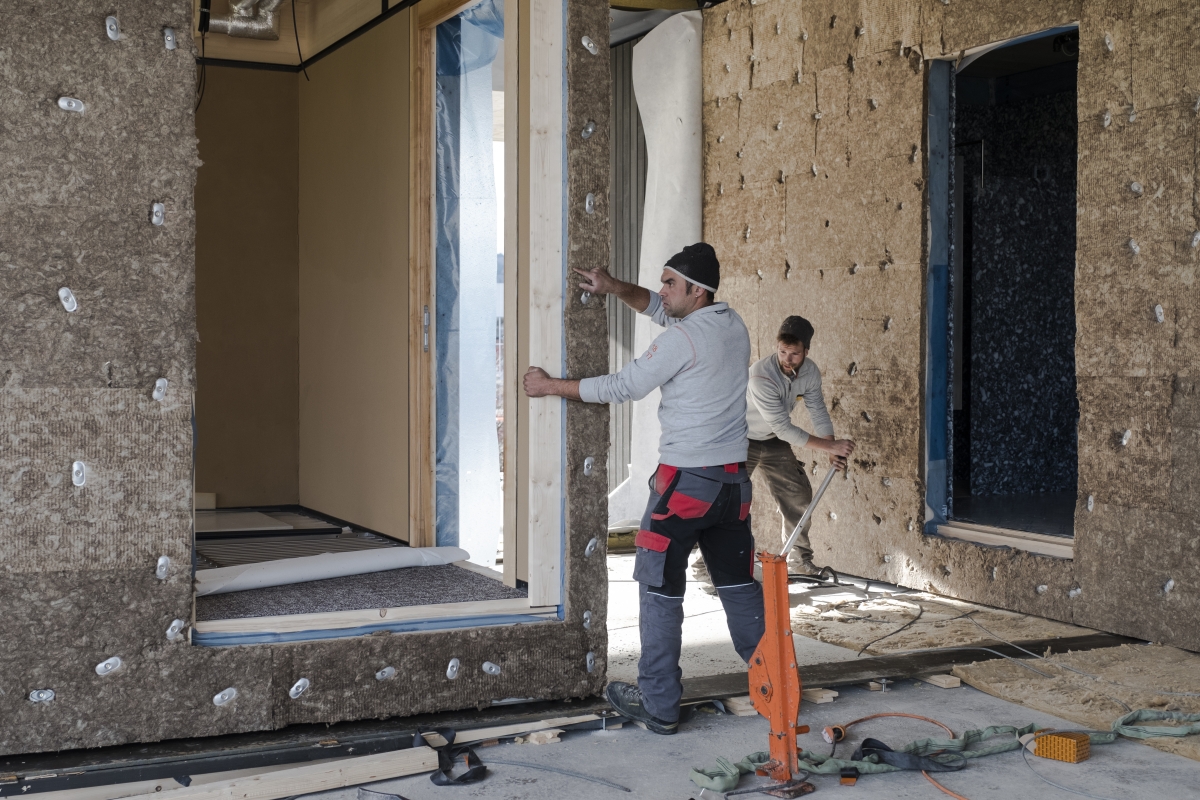(upper image) ©Einbau_Empa
While we all share the same planet, only a few of us have expressed concerns for the earth’s well-being and about the amount of damage wreaked upon nature. Making improvements to the convenience of our quality of life has now reached a state of no recovery, and we are now aware of the need to unite to tackle this shared challenge of our age described as climate change, or climate crisis. We must review what we have long taken for granted and ask ourselves: ‘does this threaten the environment?’ Correspondingly, what can we ask of architecture and what will improve our quality of life and human dignity in the midst of our ongoing climate emergency? What should we do? By reviewing a building’s life cycle from production, maintenance, and demolition, in the context of climate crisis, we will examine pertinent responses in this issue of SPACE.
STEP 1: During Construction
Question 1: How Deep and Wide Are We Digging?
Question 2: Can We Replace the Materials Most Frequently Used by Our Building Industry?
Question 3: Is It Possible to Produce Materials to Build in the City?

©ReneMueller
We are used to making sharp distinctions between what we consider to be natural and artificial, for example the natural and built environments. However, a closer inspection of artificial things such as buildings reveals that they too are composed of materials that already exist in nature. What we mean by ‘artificial’ is nothing but a rearrangement of natural molecules. What we cherish as permanent and stable is under constant transformation, partly due to the needs of humans and other animals. As soon as we accept the continuum between the natural and the artificial, our outlook on the built environment changes, both as a habitat and as material resources. With respect to the former, even the densest cities and the largest buildings become extensions of the ‘natural’ environment, resulting not only in new planning and design goals but also in a richer understanding of existing elements and structures, from the ceiling as an artificial sky to the stair as a major technological innovation that extends the human capacities for locomotion.
Our outlook on material resources is critical for the current desire to tackle climatic and environmental challenges. Waste, for example, can no longer be disposed of using costly methods such as incineration or landfills but must be understood as material out of use or out of place, begging for redeployment. This realisation has led to cyclical incentives that return these materials to use—in many ways, a welcome return to earlier periods in human history, when material resources were scarce and expensive and therefore cherished and preserved. Admittedly, back then it was cheap human labour that enabled such cycles of reuse, while today we have to rely on technological solutions.▼1 In spite of this general awareness concerning waste, overall progress is slow. An important reason for this is that most efforts are focused on processing waste, not on reducing or preventing waste. This is connected to patterns of consumption: while we have become more careful with our waste output, we consume ever greater quantities of fuel and commercial products. Consequently, waste levels remain worryingly high, similarly to other aspects of consumption, such as energy. These general trends also hold true for building construction. With the persistent emphasis on cheap labour, fast production and high turnover, building waste production remains high, despite the available know-how regarding its improved management.▼2 Perhaps the most important development in this respect is a growing adherence to circularity: many new buildings are designed with the intention that their components can be taken out and reused in another building. While this notion is appealing, there are several crucial questions concerning circularity. Firstly, the envisaged reuse, repurposing or remanufacture loops that should remain active throughout the lifecycle of building components are hard to set up and even harder to maintain beyond a period of a few years.

©Kim Hongji

©Einbau_Empa
The assumptions of circularity underlying them may prove economically unfeasible after better components enter the market or user requirements and building codes change. This also relates to the backwards application of circularity: can we reuse components from existing buildings, designed without circularity in mind? These buildings are and will remain the majority of the building stock in the foreseeable time. Extracting reusable components from them is a major technical challenge, with frequently high costs. Moreover, many components do not meet today’s specifications. Another problem is that the built environment tends to prolong the in-use life of materials. In contrast to electrical goods, our attitude towards buildings still belongs to the pre-twentieth-century preservation mentality, when people released little waste, mending and fixing rather than discarding. This makes components from existing buildings even less attractive, both qualitatively (old, worn) and quantitatively (few, irregular). One can, of course, impose faster, periodic replacement, as discussed at the end of this text. If we are unable to answer these questions, we are left with the basic option of recycling: the view of the built environment as a secondary source of materials. Rather than destroying natural resources in order to extract valuable materials, we could mine our cities for them. Urban Mining is attractive for a number of reasons: the large amounts and high concentrations of materials in cities, the high cost of sustainable material extraction from primary sources, the reduction of transport, and the independence from foreign controllers of the primary sources. The trouble with urban mining is that its optimistic outlook is not founded on a thorough understanding of the production, operation, and structures of the built environment. For example, while it is true that there are substantial quantities of steel in buildings, some of it is structural and therefore essential to their very existence, and most is in the heating and sanitary subsystems, without which building use is hardly comfortable. Steel release from operational buildings is consequently rare and irregular, unrelated to market prices for second-hand steel. It is therefore unsurprising that recycling usually follows demolition. The combination of landfill shortages, escalating disposal rates, and high prices for desirable materials makes demolition a unique opportunity that is not lost in many countries, where recovery rates for many resources are quite high. The rubble we see where a building previously stood is a veritable instance of an open mine, an outpouring of diverse materials. Demolition may be properly regulated and almost fully exploited, but renovation and refurbishment are much less so, even though they produce considerable volumes of waste. The problem is that a single new bathroom or kitchen seems incidental and too minor in the grand scheme of things to deserve regulation, even though the frequency and regularity of such incidents are quite high. Additionally, renovations and refurbishments are often rather haphazard, resulting into hibernating stock, like pipes that are no longer in use but not removed, and other wasteful relations with the rest of the building. The complicated picture that emerges from these considerations is reflective of the way we design, construct, and operate the built environment. We can blame its incoherence on the much-advertised fragmentation and conservatism of the building industry. However, arguably more important is the fact that numerous activities accommodated in the built environment have their own individual priorities and interests. All of them must be served, despite the many conflicts and contradictions. The building industry must certainly improve its performance but even then the task will remain quite demanding. Nevertheless, there are a few things we can do at the present time, with considerable short-term promise. The most fundamental is to develop information processes that capture the dynamics of the built environment, allowing us to monitor it comprehensively and reliably. This includes retaining a detailed and precise picture of components and materials released in demolition, renovation and refurbishment. Their quantities, qualities and periodicity will support more reliable and realistic planning of circularity, sustainability and other interventions—in contrast to the current guesswork on the basis of questionable proxies like construction years and a strong optimism bias.
A deeper understanding of the current state of the built environment and more robust projections of its future states may put a dampener on some of the hopes we entertain today but will also stimulate refinement of others towards sustainable application. It will help us to recognise true opportunities and to distinguish them from illusions, hypes and wishful thinking. It will also help align various stakeholders and their interests towards common goals and joint actions. The end product of such actions consists of bottom-up, incremental improvements. These could lead to the stable flow of second-hand materials from the built environment. It is important here not to assume that what is released from the built environment should return to it; what matters is that material is allowed to move between uses without loss or degradation. Bottom-up development tends to be pragmatic and therefore generally feasible and widely acceptable. At the same time, it is severely limited by the constraints of existing practices. It is therefore imperative that we also explore more radical change and challenges, primarily the overhaul of current production technologies, for example through extensive robotisation. Present applications of advanced technologies, such as 3D printing, qualify only as partial demonstrations of what the future may hold and affect little change in the building industry overall. More comprehensive changes may reveal different possibilities and needs, including concerning the trade-off between material preservation and energy expenditure—a relation lurking behind any sustainability or circularity measure.
Finally, another key change that should be considered is the move away from the mend-and-fix mentality that causes the absurd longevity of buildings and their hoarding of materials, as well a huge number of underperforming buildings. It may be preferable to stimulate faster renewal, not from a consumerist ethos but for actual large-scale economies that are hard to achieve with the current adherence to repeatedly upgrading outdated structures, often with a limited scope for performance improvement. If constant renewal rather than expansion becomes the main goal of the urbanised world, then circularity could become truly meaningful. Alternatively, we can go for a one-time upgrade of the built environment through buildings with extreme durability and high performance throughout their lifecycle. The important thing is that such choices are made on the basis of transparent, reliable information, not on a stubborn belief masquerading as idealism. (written by Alexander Kutamanis / edited by Kim Yeram)
1 A comprehensive overview of how various cultures have dealt with material, waste and consumption can be found in this book. F. Trentmann, Empire of Things: How We Became a World of Consumers, from the Fifteenth Century to the Twenty-First, London: Allen Lane, 2016.
2 A recent overview of waste management in the building industry can be found in this book. Fernando Pacheco-Torgal, Yining Ding, Francesco Colangelo, Rabin Tuladhar, Alexander Koutamanis, Eds., Advances in Construction and Demolition Waste Recycling, Duxford: Woodhead Publishing, 2020





